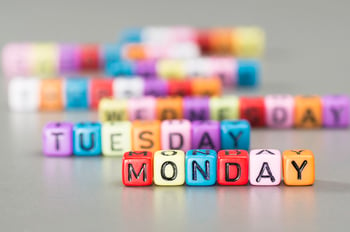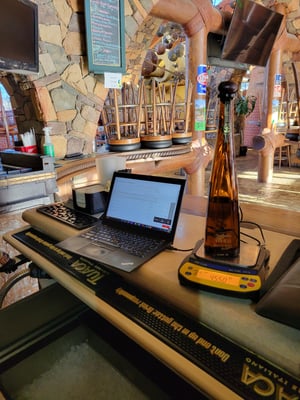 Bar inventory is one of the more tedious tasks your managers must perform. It’s slow and time consuming, but bars still take inventory because they realize that it can be quite valuable when performed correctly using state-of-the-art bar inventory software.
Bar inventory is one of the more tedious tasks your managers must perform. It’s slow and time consuming, but bars still take inventory because they realize that it can be quite valuable when performed correctly using state-of-the-art bar inventory software.
To illustrate the potential value you can experience from your inventory efforts, let’s look at an example of a typical medium sized bar doing roughly $50,000 in monthly sales. If this bar has a 20% liquor cost, it means they spend $10,000 each month purchasing the products they sell. If they experience industry average 15% shrinkage, it will result in this bar wasting $1,500 a month on products that are being poured, but not sold.
One way of determining the true value of this inventory shrinkage is to say that with a 20% liquor cost, selling that missing $1,500 of product would result in an additional $7,500 gain. This figure represents the maximum amount of profit you’d capture by selling all of this missing product (with a 20% liquor cost, you’re selling your products for five times what you pay for them).
In reality, it’s unlikely that you will achieve that full level of additional profit since there are many factors impacting the true value of inventory shrinkage. However, you’re almost certain to capture enough of this extra profit to justify the cost of a sophisticated inventory system that can help you reduce shrinkage and improve your bar’s performance. Most bar inventory systems start at around $200 per month, so with a potential upside of as much as $7,500 for using this system, the likelihood that you’ll achieve an excellent ROI on your bar inventory system investment is extremely high.
While using an effective bar inventory system is a critical factor to your ability to leverage your inventory efforts as a profitability tool, there are other factors that will impact your ability to get the most out of this process. The following tips will help you to manage your bar inventory process more effectively in order to maximize your profits.
Use Bar Inventory Software
Using bar inventory software will make the counting process faster and more accurate. If you’re using a well-designed system that incorporates a shelf to sheet inventory process, it will also improve the auditability of your inventory counts, allowing you to get better, more actionable results.
Inventory software gives you the ability to integrate your purchases and sales, which is essential to getting the most out of the inventory process. If you want to use your inventory efforts to increase profits, you need to be able to compare what was poured vs. sold for every product you carry. Most POS systems are highly complex and require a large number of unique buttons to account for all the different size pours and different types of drinks you serve. As a result, the only way to get an accurate record of what you sold is to use bar inventory software that has a recipes module built into the system. This will allow you to accurately account for every ounce of liquor used for every drink rung into your system, making it easier to compare what was poured vs. sold.
Count Inventory on a Weekly Basis
Any bar doing at least $50,000 in monthly bar sales should be performing weekly inventory counts. There are many potential opportunities for errors in the inventory process. When you’re only doing monthly counts, it’s extremely difficult to determine the source of these errors and resolve them in a way that allows you to achieve the accurate data necessary to make more money from your bar inventory management.
Have the Same Person Count Inventory Each Week
Having one employee manage the inventory process is the most effective approach. When different people are responsible for this task each week, it will introduce unnecessary complexity and confusion over the process since each person may perform the inventory counts a little differently.
If you’re dead set on having more than one person manage the bar inventory process, the best approach is to have the same employee perform every inventory count for a three-month period and then switch to a different employee who will own the process for the next three months. This ensures you’ll have greater consistency in your inventory process from week to week, which will reduce errors and increase your confidence in your numbers.
Pick a Set Day of the Week for Your Inventory Counts
 We often see bars want to perform their inventory counts on a specific date, such as the first of the month, for accounting purposes. The problem with this approach is that this date will fall on a different day of the week each month, creating a situation where the employee managing your inventory will be forced to come in on their day off once in a while to perform inventory counts. Your employees are less likely to give this task the time and attention it deserves when they have to come in on their day off. They’ll want to get the process done as fast as possible so that they can go home and enjoy their day off, and this type of attitude increases the likelihood of errors.
We often see bars want to perform their inventory counts on a specific date, such as the first of the month, for accounting purposes. The problem with this approach is that this date will fall on a different day of the week each month, creating a situation where the employee managing your inventory will be forced to come in on their day off once in a while to perform inventory counts. Your employees are less likely to give this task the time and attention it deserves when they have to come in on their day off. They’ll want to get the process done as fast as possible so that they can go home and enjoy their day off, and this type of attitude increases the likelihood of errors.
Ideally, you should pick a set day of the week that will be dedicated to managing your inventory counts. We recommend picking a day early in the week (Monday or Tuesday) when your inventory is at lower stock and your managers have more time during their shift to devote to this task. Performing inventory counts on the weekend when your bar is busy and fully stocked is much less ideal and can increase the likelihood of errors.
If you use Bar-i’s software and your set inventory day falls slightly before or after the first of the month, our software can project what the value of your inventory was on the first. Our projections are highly accurate, allowing you to determine your end of month inventory values with confidence and fulfill these important accounting responsibilities.
Integrate Your Purchases and Sales
If you’re only performing inventory to figure out what you need to order, all you have to do is count what you have on hand and you’ll be able to see how much of each product needs to be ordered each week. However, this low-level inventory function won’t help you determine what’s missing so that you can reduce your inventory shrinkage. To accomplish this goal, you need to integrate your purchases and sales so that you can compare what is poured vs. sold, a process we call level 3 inventory.
Analyze Your Inventory Data
The standard approach in the level of detail associated with inventory counts typically goes beyond figuring out what to order. Most bars will also use their inventory efforts to calculate their liquor cost by category (draft beer, bottled beer, liquor and wine). The problem with this approach is that there is significant variability in the liquor cost of different tiers of products within each category. For example, the liquor cost of wells is typically much lower than the liquor cost of premium spirits, so when you blend those costs together, you lose a lot of detail. This makes it much harder to see how specific products are performing.
To get the most out of your inventory efforts, you need to analyze the data at a much higher level. At Bar-i, we count inventory down to the serving for every product https://blog.bar-i.com/the-7-elements-of-verified-to-the-serving-bar-inventory. This lets you see how many servings of each product were poured and how many servings were sold. This granularity in your data opens up a whole new level of analysis that lets you see how your bar is actually performing. With this level 3 inventory data, you can see:
- Exactly how many servings of every product are missing each week
- Your liquor cost on individual drinks
- Your liquor cost on individual products
When you have this detailed level of data analysis, it provides you with the actionable information necessary to reduce shrinkage and increase profits.
Scan Barcodes to Enter Products into Your Inventory System
A lot of bar inventory systems will require you to look up products by name. This significantly increases the likelihood of confusion and errors. It’s easy to select the wrong size (750 mL vs. 1L bottle), flavor (Stoli Citrus vs. Stoli Orange) or year (Macallan 12 year vs. Macallan 18 year) of a particular product with this approach.
Using barcodes to enter products into your inventory system is a much simpler and more effective way to approach this task. Inventory systems such as Bar-I, which identify products by scanning the barcodes, eliminate the risk of choosing the wrong product. Just scan the barcode on the side of the bottle and the correct item will come up every time. This cuts down on the time spent hunting for the right product in a dropdown menu, and it eliminates any errors that will impact the accuracy of your inventory data if you accidentally select the wrong item in a menu full of product names that look nearly identical.
Use Scales to Perform Your Inventory Counts
 It’s important to get an extremely accurate count on all your liquor bottles so that you can know exactly how many servings were poured each inventory cycle. This is especially true for your low volume, high end products where very few drinks are poured each week. When you are missing a few servings of these liquors, it can have a significant impact on your bottom line.
It’s important to get an extremely accurate count on all your liquor bottles so that you can know exactly how many servings were poured each inventory cycle. This is especially true for your low volume, high end products where very few drinks are poured each week. When you are missing a few servings of these liquors, it can have a significant impact on your bottom line.
Using scales to measure how much is left in each bottle will give you the granularity necessary to know how these products are performing. For example:
- You can see if a single shot was poured
- You can see if bartenders are pouring neat pours, but only charging for a single
When you have this granular data for every product, you can take the proper steps necessary to ensure every serving of these high-end products is being rung into your POS correctly so that you maximize your profits on these premium items. Using scales also allows you to test and measure your POS setup and the precision of your bartenders. This information will help you identify any buttons that need to be added to your POS system or of determine when your staff needs additional training, such as pouring practice, to ensure they’re portioning your drinks correctly.
When you use Bar-i’s system and leverage our shelf to sheet mapping capabilities, it takes about 2.5 seconds to weigh each bottle. This makes using scales both faster and more accurate than implementing an inventory system that uses a tenthing method to see how much is left in each bottle.
Consider the ROI of Your Inventory System Instead the Cost
If you look to implement the most affordable bar inventory system, you may save $100 per month on your inventory costs, but you may also potentially lose out on thousands of dollars a month in extra profits due to the less accurate and granular data provided by these cheaper systems. Rather than looking at the amount of money you’re spending on your inventory solution each month, you should evaluate the ROI you achieve from this system. This will help you understand the true value your inventory system is providing to your bar.
It's important to think about whether the bar inventory system you choose is actually helping you solve the problem at hand – shrinkage levels that are higher than they need to be. To solve this problem, you need to be able to accurately measure how much of every product is missing each inventory period. If you need to spend a little extra money on an inventory system that provides you with these capabilities along with expert assistance during each inventory count, robust data analysis and expert recommendations, this expense will typically be insignificant compared to the extra money you will make in profits when you’re able to reduce shrinkage and capture more dollars in sales each week.
Often, spending an extra $100-200 each month on your inventory system can equate to several thousands of dollars in extra profits. This should be a no brainer due to the extreme value you’re receiving for such a small additional expenditure.
Use Inventory Software for More Intelligent Ordering
One of the most common problems we see among bars when they first start working with us is that they have issues with their ordering. This typically manifests in one or more of the following ways:
- They have too much inventory on hand
- They run out of certain products
- They carry too large of a product selection
When you use sophisticated bar inventory software, you can manage your ordering as part of the inventory process. If you count inventory on a weekly basis, it’s very easy to compare your current count to the pars you establish for each product. This will help you determine exactly how much of every product you need to order each week.
Bar-i’s inventory system uses dynamic pars which automatically update as the software learns what your average usage is for each product. In situations where product usage varies seasonally, your pars will change to reflect this. Our dynamic par system provides the most accurate ordering data, ensuring you have exactly what you need on hand at all times – you won’t overorder, and you won’t run out of products.
If you would like to learn more about how Bar-i’s liquor inventory system can help streamline your processes and maximize your profitability, please contact us today to schedule a free consultation. We serve clients nationwide from our offices in Denver, Colorado.


-1.png)